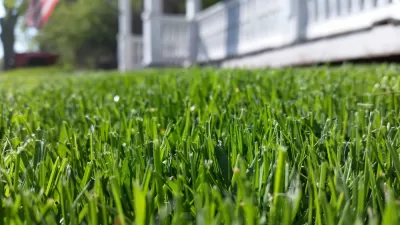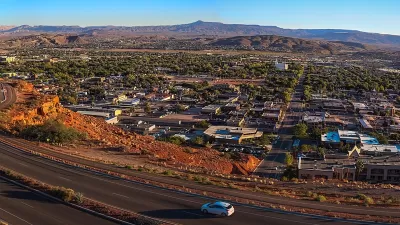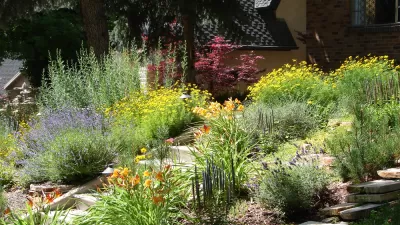Long held as a symbol of middle-class success and the American Dream, homogenous, monocultural lawns are quickly falling out of favor as people opt for more ecologically friendly gardens that conserve water and increase biodiversity.

Writing in the Washington Post, Dan Zak examines the American obsession with lawns and the growing anti-lawn movement gaining steam in an era of extreme water shortages.
American suburbia has long been defined by “Lawns: emerald green — no, alien green — and kept that way by maniacal vigilance and an elaborate system of pipes and potions, organic and otherwise, in defiance of ecology.” Zak positions awns as a container for our national anxieties, writing: “We’ve been sweeping our anxieties under these green comfort blankets for quite some time.”
In the early and middle parts of the twentieth century, “Lawns were a sign of taste, calm, power, privilege, order, discipline, especially in the aftermath of World War II.” More recently, that trend has reversed, as lawns “began to signal waste, disregard, disharmony, homogeneity, gentrification, zombie Boomerism.” While ornamental lawn grass is still the biggest crop in America, using 9 billion gallons of water a day, attitudes are shifting. “California’s main water utility is paying customers between $2 and $5 for each square foot of living turf that they remove. Last year Nevada outlawed certain types of lawn; rather, the state legislature prohibited the use of water from the dribbling Colorado River to feed certain types of “nonfunctional turf,” which in southern Nevada slurps up to 12 billion gallons of water every year (more than 10 percent of the state’s usage of the river).”
As landscaper Dave Marciniak points out, “Turf serves a purpose, he wrote. It’s soft and durable for recreation. It provides visual relief for the eye, and contrast for landscaping.” But other materials and plants can serve the same purpose, and more lawn devotees are realizing the potential of xeriscaping and other eco-friendly ways to replace lawns with sustainable, locally appropriate landscaping.
FULL STORY: There’s a water crisis. Why do we still have lawns?

Alabama: Trump Terminates Settlements for Black Communities Harmed By Raw Sewage
Trump deemed the landmark civil rights agreement “illegal DEI and environmental justice policy.”

Study: Maui’s Plan to Convert Vacation Rentals to Long-Term Housing Could Cause Nearly $1 Billion Economic Loss
The plan would reduce visitor accommodation by 25% resulting in 1,900 jobs lost.

Why Should We Subsidize Public Transportation?
Many public transit agencies face financial stress due to rising costs, declining fare revenue, and declining subsidies. Transit advocates must provide a strong business case for increasing public transit funding.

Paris Bike Boom Leads to Steep Drop in Air Pollution
The French city’s air quality has improved dramatically in the past 20 years, coinciding with a growth in cycling.

Why Housing Costs More to Build in California Than in Texas
Hard costs like labor and materials combined with ‘soft’ costs such as permitting make building in the San Francisco Bay Area almost three times as costly as in Texas cities.

San Diego County Sees a Rise in Urban Coyotes
San Diego County experiences a rise in urban coyotes, as sightings become prevalent throughout its urban neighbourhoods and surrounding areas.
Urban Design for Planners 1: Software Tools
This six-course series explores essential urban design concepts using open source software and equips planners with the tools they need to participate fully in the urban design process.
Planning for Universal Design
Learn the tools for implementing Universal Design in planning regulations.
Smith Gee Studio
Alamo Area Metropolitan Planning Organization
City of Santa Clarita
Institute for Housing and Urban Development Studies (IHS)
City of Grandview
Harvard GSD Executive Education
Toledo-Lucas County Plan Commissions
Salt Lake City
NYU Wagner Graduate School of Public Service





























